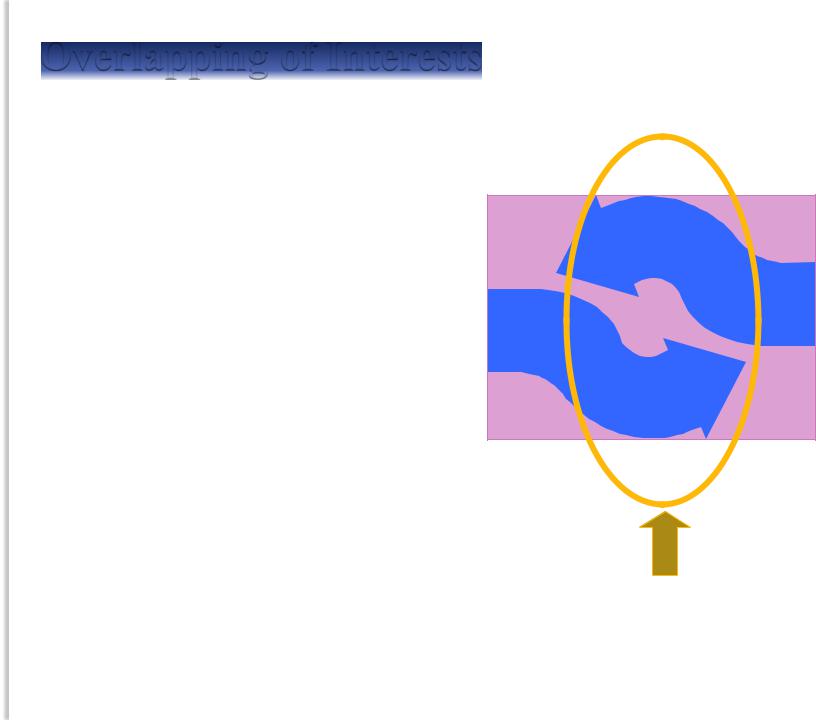
Business Communication by Edwards 2012
.pdf
collaborating, competing, compromising, accommodating, and avoiding (by technology);
internal and external (by parties origin – domestic and international);
commercial and partnering (by the objective to achieve);
face-to-face, via mail, during special events (by communication type);
role-playing, psychodrama, brainstorming, talks
(by position presentation);
reasonable and constructive or unreasonable and destructive (by the flow character and the outcome achieved)
Natalie M. Edwards 2012 |
41 |

Need in negotiations appears when: a conflict arises;
when both parties do not fully control the situation.
Objective:
•To come to an agreement acceptable for both sides and to preserve the overall relationships (superficial)
•To obtain a profit (true)
Even if the battle is won, the war can be lost
Natalie M. Edwards 2012 |
42 |

Overlap – to have something in common with: comprehend elements of; coincide in part with;
Overlap (noun): the condition or relationship of things that overlap.
(WEBSTER’S THIRD NEW
INTERNATIONAL DICTIONARY, v.2, Encyclopedia Britanica, Inc., 1996).
Overlap of interests:
90-100% - no need in negotiations, coincidence is obvious, the agreement could be achieved in the course of correspondence or through signing the documents (Contract, agreements or protocols)
30-90% - subject to negotiating
0 – 30% - too early to negotiate, a longer preliminary work is required
=
Area of overlapping - area of interests coincidence
Natalie M. Edwards 2012 |
43 |

Content preparation – analytical technologies-pre-negotiation phase
Research the Partner
Research the national or local dimensions
Thorough analyses of the subject
Position identifying
Problem tree
Suggestions and offers
Documentation prepared
In-company talks
Participants instructing
Natalie M. Edwards 2012 |
44 |

Partners: people, groups or institutions with interests in joint cooperative work. Research the potential partner implies:
to obtain proper info on the company and the team participants
research the facts of the partner’s
business activities
partnering companies and firms financial and legal sustainability prospective development trends
Used:
open source data available in business edition
on the Internet, especially on the company’s home website
through the national Chamber of Commerce or other intermediary agencies
in Western countries and in the US - it is habitual to publish annual reports where all required data can be easily found.
Natalie M. Edwards 2012 |
45 |

Get introduced to:
national (or local) specific do and dont’s
greeting and farewell in the language
the national history, culture and cuisine
the way of making business and negotiating which may be characteristic of a
prospective partner’s location.
Many men – many minds policy brings along choices.
Natalie M. Edwards 2012 |
46 |

A thorough analyses of the negotiation subject area covers the subject history, strong and weak sides of both parties, and the motivation analyses.
1)Planning the negotiating area: search for a better way and its thorough study . Plans strongly depend on the objectives and the facilities available (not just funding or material auxiliary resources, but the human resources capable of realizing the decisions made and proceeding from their abilities and professional competences).
2)The subject to be researched is also the circumstances attendant with the decision selected. It Is necessary to answer the following questions:
Are there any legal contradictions?
What precedent cases are available as sample cases?
Which consequences are possible to foresee?
What are the frame limits of already existing decision area?
Are probability-related data used for negotiating the subject?
3) The answers outline the “negotiating area of the talks”. This if the frame within which the decisions are made, when all the circumstances are studied.
4) Next, the decision realization tools are considered:
who does what and by what date;
which the basic activities are;
how the negotiation stage moves into another one.
Natalie M. Edwards 2012 |
47 |

S - specific
M - measurable A - achievable R - realistic
T - time-bound
S - To launch the production cycle M - for 1 mln. semiconductors
A - according to the Japanese
R - technology at our Sayanogorskbased branch plant and by its
T - workforce, in a two-month’s time.
Natalie M. Edwards 2012 |
48 |

S - STRENGTHS: |
W- WEAKNESSES: |
•Good contacts with professional |
•Outdated technology or equipment; |
organisations |
•Shortage of staff; |
•Well-located |
•Inflexible administrative system; |
•Well-qualified and motivated staff |
•Inadequate employment services to find |
•Quality-based procedures for appointing |
specialists locally; |
tasks or staff |
•No international cooperation experience; |
•Medium experience on international |
•Poor language skills for communication; |
deliveries and taxation |
|
O - OPPORTUNITIES: |
T - THREATS: |
•Cooperation with donor-funded |
•Low salaries; |
organizations; |
•Poor telecommunications; |
•Stable political environment; |
•Rapidly changing social and economic |
•Well-established relationships with |
environment; |
potential partner industries; |
•Possible brain-drain. |
•Up-grading courses for staff; |
|
•Use of international or neighbour region |
|
employment agencies to find staff; |
|
|
|
Natalie M. Edwards 2012 |
49 |

|
|
|
|
|
|
|
|
|
|
|
|
Natalie M. Edwards 2012 |
50 |
|
|
|
|
|
|
